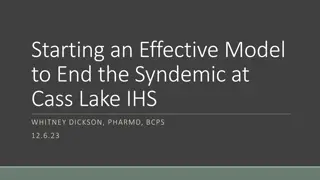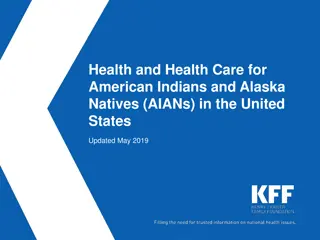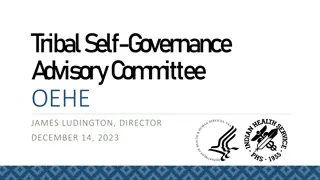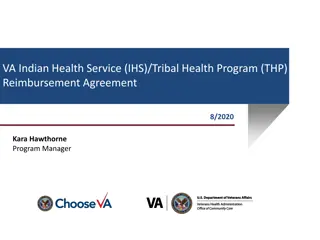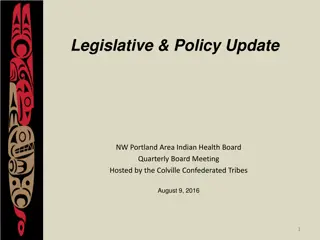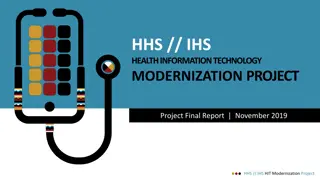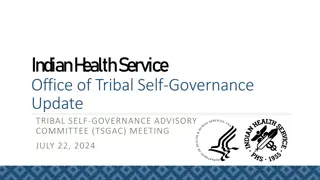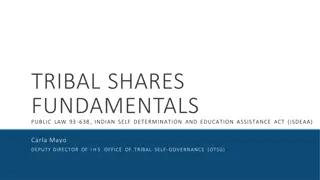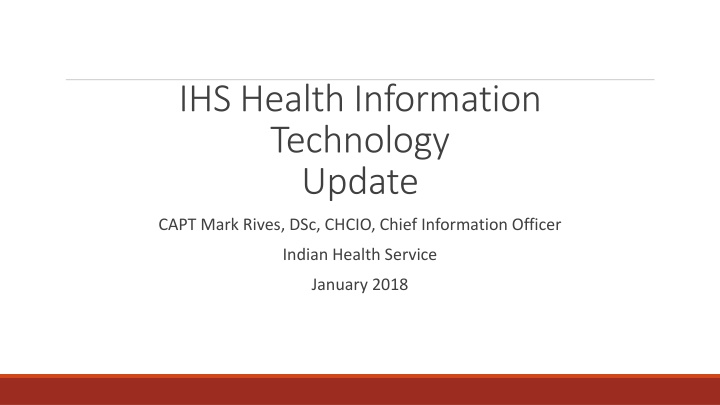
IHS Health Technology Update & Recent Cybersecurity and Health IT Events 2018
Stay informed on the latest updates in Indian Health Service technology, recent cybersecurity events like ransomware outbreaks, and the response to VA's announcement to leave VistA. Learn about RPMS EHR history, certifications, deployments, and the relationship between IHS RPMS and VA VistA systems.
Download Presentation

Please find below an Image/Link to download the presentation.
The content on the website is provided AS IS for your information and personal use only. It may not be sold, licensed, or shared on other websites without obtaining consent from the author. If you encounter any issues during the download, it is possible that the publisher has removed the file from their server.
You are allowed to download the files provided on this website for personal or commercial use, subject to the condition that they are used lawfully. All files are the property of their respective owners.
The content on the website is provided AS IS for your information and personal use only. It may not be sold, licensed, or shared on other websites without obtaining consent from the author.
E N D
Presentation Transcript
IHS Health Information Technology Update CAPT Mark Rives, DSc, CHCIO, Chief Information Officer Indian Health Service January 2018
Recent Cybersecurity Events Cybersecurity events Ransomware outbreaks WannaCry Petya Not-Petya Impacted many organizations around the globe IHS and Tribal IT organizations worked together to address vulnerabilities Meltdown and Spectre 10 year old vulnerability All Devices with processors DHS reporting Impacted cloud-service providers most
Recent Health IT Events VA announcement to leave VistA VA Sec Shulkin announced in June 2017 18 months before first implementation 8-9 years transition IHS response Already planning a Health IT modernization effort Working closely with stakeholders Working closely with HHS
RPMS EHR History The Indian Health Service has long been a pioneer in using computer technology to capture clinical and public health data. The IHS clinical information system is called the Resource and Patient Management System (RPMS). RPMS development began nearly 30 years ago, and many facilities have access to decades of personal health information and epidemiological data on local populations. The primary clinical component of RPMS, Patient Care Component (PCC), was launched in 1984. The RPMS EHR graphical user interface represents the next phase of clinical software development for the IHS and was launched in 2004.
RPMS EHR and MU In April 2011, the IHS Resource and Patient Management System (RPMS) was certified according to standards established by the Office of the National Coordinator for Health Information Technology (ONC). This accomplishment allowed Eligible Professionals (EPs) and Eligible Hospitals (EHs) to participate in the Centers for Medicare and Medicaid Services (CMS) EHR Incentive Program. With the release of the 2014 ONC Rule and the 2014 CMS Stage 2 Rule, the scope of requirements for demonstrating Meaningful Use were greatly increased, and new certified electronic health technology (CEHRT) became necessary. As of August 22, 2014, the 2014 RPMS EHR was certified according to the 2014 ONC standards
Veterans Administration & VistA IHS RPMS and VA VistA had shared start RPMS and VistA are open source software IHS relies on VA for some software development IHS adapts VA software code then adds additional code for additional capabilities VA Announcement to leave VistA means that IHS loses a source of software code development that we did not have to fund
Impact on the Resource and Patient Management System (RPMS) and IHS stakeholder engagement Held four listening sessions and gathered comments. Plus, received 22 sets of comments via email and mail Engagement at all levels within HHS. VA, HHS OCTO, HHS ONC, USCG, DoD MHS, tribal health programs, TSGAC, DSTAC, HHS ASFR, and numerous industry analysts. Developed Request for Information (RFI) Goal: Ask industry what they would propose as a solution Anticipated outcome: Good understanding of HIT as a foundation for a larger strategy Status Published in FedBizOps / Response due date: Feb 1
RPMS Pros Cons Historically focused on Population Health and improving clinical outcomes Increased functionality demands/requirements outpacing development capabilities Designed by and for use in AI/AN healthcare delivery Source of software development limited to IHS/OIT Designed to meet specific functionality (i.e. PRC) Limited sources of training and support Multiple SureScripts White Coat of Quality awards, two Davies awards, two ComputerWorld awards, and an HHSInovates Award. Heavy reliance on local system administration and configuration Heavy reliance on contracted development Doing it all strains priorities for update/development Mega-suite EHR platform Does it all
Information Systems Advisory Committee (ISAC) Purpose: Established to guide the development of a co-owned and co-managed Indian health information infrastructure and information systems. Goal: assure the creation of flexible and dynamic information systems that assist in the management and delivery of health care and contribute to the elevation of the health status of Indian people. Charter: Located on IHS.GOV/ISAC Note: Being revised to simplify membership nomination and expand tribal participation Meetings & Calls Last: Oklahoma City Sept 2017 Next call: December 8, 2017 Next meeting: Phoenix Area March 2018
Update from ISAC Meeting, September 19-20, 2017 Recommendations The ISAC recommends the IHS Chief Information Officer (CIO) provide a standing report on the monthly All Tribes conference call for transparency in Information Technology (IT)/Health IT (HIT) programs, services, functions, and activities. The ISAC advocates for continued collaboration between IHS and the Veterans Affairs (VA) and the Department of Health and Human Services (HHS) on HIT modernization efforts, acknowledging the initiative is in early discovery right now. The ISAC recommends the IHS go forward with a budget request for HIT modernization as soon as feasibly possible. The ISAC recommends that the IHS and OIT strategic plans include reference to the OIT Human Capital Management Plan.
Update from ISAC Meeting, September 19-20, 2017 - Actions The ISAC continues to work on updates to the ISAC Charter. The ISAC continues to work on updates to the OIT Human Capital Management Plan to place more emphasis on Informatics positions and updating IT position descriptions. The ISAC will continue work on revising the FY 2018-2019 IT Priorities to add HIT modernization, infrastructure, a phased approach for modernization, and process improvement. The IT priorities will be shared with IHS management, Areas, Tribes, and other stakeholder groups.
Factors to consider IHS is taking an advanced posture to plan for Health Information Technology Systems modernization. RPMS and VISTA will continue to be supported in the near term only. RPMS development to date has always been supported by and dependent upon the VISTA platform. There is the potential for significant cost savings and efficiencies by moving to a common Federal EHR platform. IHS has unique needs for patient care, population health management, and referral management and many of those are different from the VA and DoD- but a common federal platform may allow for the type of local flexibility many areas may desire.
Factors to consider, concl. IHS clinicians, administrators, tribes and tribal organizations and other stakeholders will be very involved in how the process moves forward and in the implementation of the system. In many ways IHS is well ahead of peers in clinical IT innovations and we will not discard our past work. And our work will help other partners in turn. Furthermore IHS must obtain interoperability with VA, DoD, tribal and urban programs, academic affiliates, and community partners, many of whom are on different IT platforms. We must consider an integrated product that will require a meaningful integration with other vendors to create a system that serves IHS, tribal, and urban beneficiaries in the best possible way.
Vision We need technology to support the IHS mission to raise the physical, mental, social, and spiritual health of American Indians and Alaska Natives to the highest level. This includes (but is not limited to) support for: Patient and family centered medical home Patient access to the medical record Interoperability Behavioral health / integrated care / traditional approaches Specialty care coordination / referrals Population health approaches Creative and innovative solutions with a look to the future Data analytics Data reporting Billing / revenue generation
Near term Plans for IHS HIT Platform Must continue to develop interoperability functionality to ensure access to patient data. Continuing development for EPCS New Medicare Cards (NMC) 8 RPMS applications that will require modifications Expected to release in Feb 20, 2018 (FY18Q2 release) Other minor application updates for reporting will occur throughout 2018 to address reports. Routine Updates Update schedule to be published on IHS.Gov All options are still in consideration. Working towards a broader HIT Modernization initiative
Questions? Mark.Rives@ihs.gov

